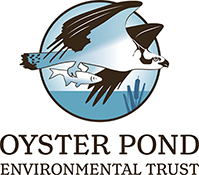The Silent Spring Institute discovered that hormone-disrupting chemicals such as natural estrogen and alkylphenols, as well as certain pharmaceuticals are passing through septic systems, entering the groundwater and then migrating to ponds. The researchers detected two other chemicals that indicated the presence of sewage effluent — optical brighteners, found in laundry detergents, and caffeine. Oyster Pond was one of the study sites and these compounds were detected more frequently and at higher concentrations than in ponds with less dense development. While risks to human health are yet unknown, found concentrations approach those that are have been shown to feminize fish.
Kathleen Attfield, Staff Scientist from the Silent Spring Institute, was the keynote speaker at OPET’s Annual Meeting in 2009. The title of her talk was “Drug and Hormonal Pollutants in Oyster and other Cape Cod Ponds”.

